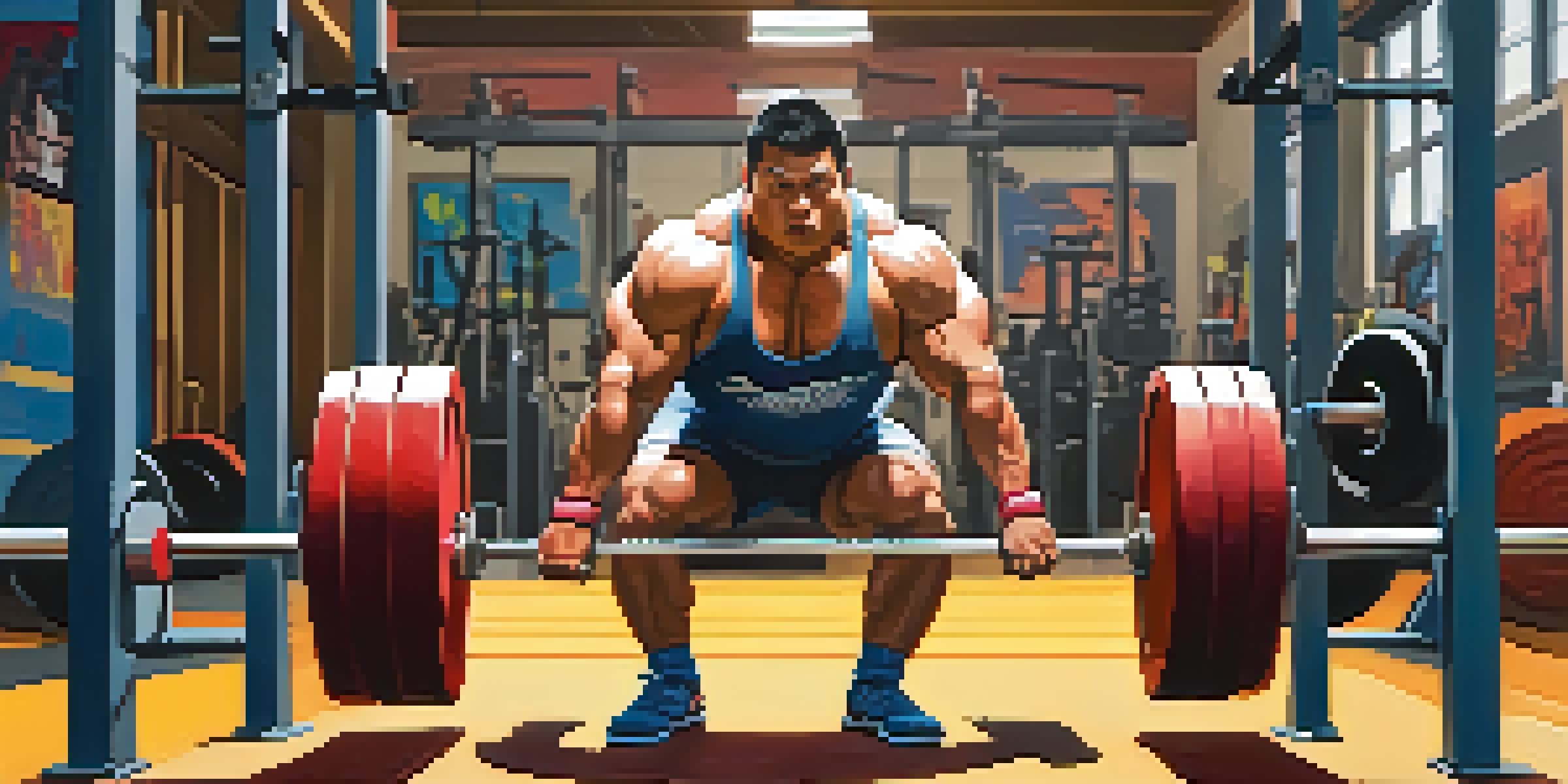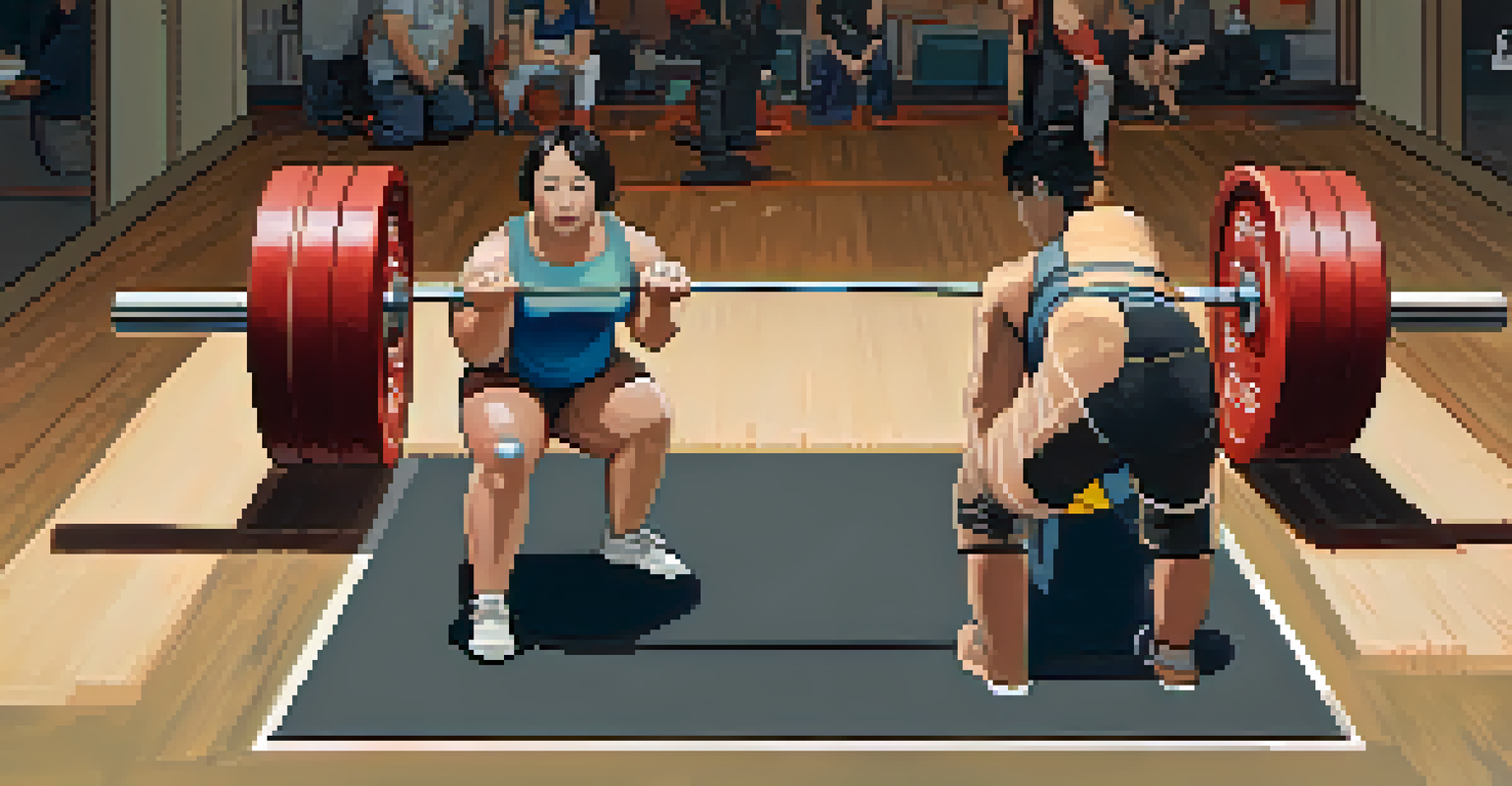Sumo Deadlift: Technique and Benefits for Powerlifters

What is the Sumo Deadlift and Why Use It?
The sumo deadlift is a variation of the traditional deadlift, characterized by a wider stance. This positioning allows for a more upright torso, which can reduce stress on the lower back. Many powerlifters favor the sumo deadlift for its potential to lift heavier weights due to the biomechanics involved.
Strength does not come from physical capacity. It comes from an indomitable will.
Unlike the conventional deadlift, where feet are closer together, the sumo stance can help engage the legs, particularly the quads and glutes, more effectively. This makes it a great choice for lifters focused on building strength in these muscle groups. Additionally, the wider grip helps create a stable lift, which can be beneficial for competitive powerlifting.
Incorporating the sumo deadlift into your training routine can diversify your workout and challenge your body in new ways. It’s not just about lifting heavy; it’s about improving overall strength and performance in powerlifting competitions.
Key Techniques for Mastering the Sumo Deadlift
To perform the sumo deadlift effectively, start by positioning your feet wider than shoulder-width apart. Your toes should be pointed slightly outward, allowing your knees to track over your toes as you lift. The grip should be inside your knees, which helps in maintaining balance during the lift.

As you prepare to lift, focus on keeping your chest up and back straight. This alignment is crucial, as a rounded back can lead to injury. Engage your core before initiating the lift; this stability will help you maintain form as you pull the barbell off the ground.
Sumo Deadlift Enhances Strength
The sumo deadlift targets specific muscle groups and can improve overall strength and performance in powerlifting.
Lastly, practice the movement with lighter weights before progressing to heavier loads. This will help you develop muscle memory and ensure that your technique is sound. With consistent practice, you'll notice improvements in your strength and confidence in executing the sumo deadlift.
Common Mistakes to Avoid in the Sumo Deadlift
One common mistake lifters make is allowing their back to round during the lift. This can not only limit your lifting capacity but also increase the risk of injury. Always prioritize a flat back by engaging your core and keeping your chest up throughout the movement.
The only way to prove you are a good sport is to lose.
Another mistake is using a grip that’s too wide or too narrow, which can throw off your balance. Finding the right grip width is essential; it should feel comfortable and allow your arms to hang naturally. If you feel like you're struggling to keep the bar close to your body, it may be time to adjust your grip.
Lastly, be mindful of your knee positioning. Allowing your knees to cave in during the lift can lead to instability and potential injuries. Focus on pushing your knees outwards, aligning them with your toes, to maintain a strong and safe position throughout the lift.
Benefits of the Sumo Deadlift for Powerlifters
The sumo deadlift offers several benefits that can enhance a powerlifter's performance. One of the main advantages is its ability to target different muscle groups compared to the conventional deadlift. This variation not only builds leg strength but also enhances hip mobility, which is crucial for overall athletic performance.
Additionally, sumo deadlifts can be easier on the lower back for some lifters, making it a safer option for those with pre-existing back issues. The upright torso position minimizes the strain on the spine, allowing lifters to focus on building strength without the discomfort.
Key Techniques for Success
Proper foot positioning, grip, and core engagement are essential for executing the sumo deadlift effectively and safely.
Incorporating the sumo deadlift into your training regimen can lead to improved lifting mechanics and greater overall strength development. This can translate to better performance in competitions, as well as an increase in your overall lifting capacity.
How to Incorporate Sumo Deadlifts into Your Routine
When adding sumo deadlifts to your training program, it’s vital to consider how they fit with your overall goals. If you're aiming for strength gains, consider integrating them into your lower body days. Doing so will allow you to focus on building the necessary muscle groups for optimal performance.
It’s also important to vary your sets and reps when incorporating sumo deadlifts. For instance, you might work on heavy sets with lower reps one week and switch to lighter weights with higher reps the next. This variation helps to prevent plateaus and keeps your workouts fresh and engaging.
Lastly, ensure you’re complementing sumo deadlifts with other exercises that target your posterior chain, such as Romanian deadlifts and glute bridges. A well-rounded training program will not only enhance your sumo deadlift performance but also improve your overall strength and powerlifting results.
The Role of Mobility in Performing Sumo Deadlifts
Mobility plays a crucial role in executing the sumo deadlift effectively. A wider stance requires good hip and ankle flexibility, which can significantly impact your lifting mechanics. Before attempting heavy lifts, it’s beneficial to incorporate mobility exercises that target these areas.
Dynamic stretches, such as leg swings and hip circles, can help increase your range of motion. Additionally, foam rolling your hips and legs before lifting can release any tight muscles, allowing for a smoother movement pattern. Maintaining adequate mobility will not only enhance your performance but also reduce the risk of injury.
Mobility is Crucial for Lifting
Incorporating mobility exercises is vital for executing the sumo deadlift with proper form and reducing the risk of injury.
By prioritizing mobility training alongside your sumo deadlift practice, you’ll find that your lifts become more efficient and powerful. This focus on flexibility can make a noticeable difference in how you perform not just the sumo deadlift, but all aspects of your powerlifting routine.
Conclusion: Elevating Your Powerlifting Game with Sumo Deadlifts
In conclusion, the sumo deadlift is a powerful tool for any serious powerlifter. Its unique technique and benefits can enhance your overall strength and performance. By mastering the sumo deadlift, you can diversify your training and target muscle groups that may not get as much attention with traditional lifts.
Remember to focus on proper technique, avoid common mistakes, and incorporate mobility work to maximize your gains. As you progress, you’ll likely find that your confidence in lifting increases, along with your overall performance in competitions.

So, whether you’re a seasoned powerlifter or just starting, don’t hesitate to integrate sumo deadlifts into your training regimen. With dedication and practice, you’ll elevate your powerlifting game and achieve your lifting goals.